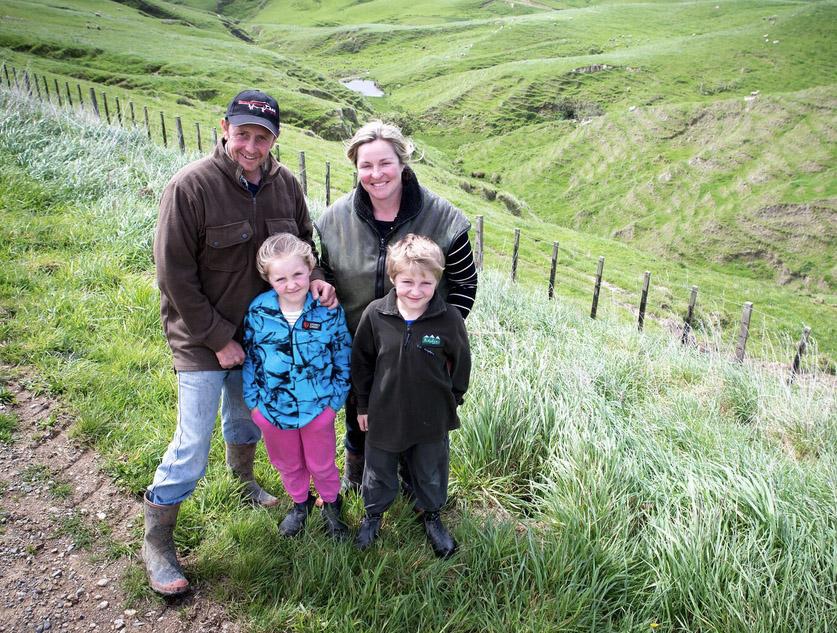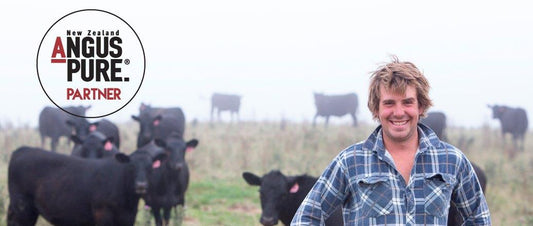Take only photographs, leave only footprints; that’s right isn’t it? Well instead of footprints it was tyre marks a foot deep in the paddocks at Brookwood Station, as I was transported in my mind from Hawke’s Bay to Southland.
“Oh, it’s quite a dry climate,” says Justin.
So much for the Hawke’s Bay droughts, I thought…
Justin and Meg King came to Brookwood, just five minutes from Takapau, in 2005 after Justin became disillusioned with his role as a rural manager for Rabobank. Both were from stud farming families but decided they wanted to buy Brookwood, an 1125ha easy-medium hill country property, which had great scope for development, says Justin.
They started with a farm that was in good order, but had very little infrastructure, no water troughs and very few fences. Initially, they thought that 9000 ewes was the answer to getting the place up and running.
It wasn’t long, however, before the stud breeder gene kicked back in for Justin.
“There’s a bit of that genetic chasing, stud improvement gene in my blood I reckon.”
He wanted that challenge as he believes that breeding stud cattle has a different dynamic to fattening and trading.
“You always have to be one step ahead, anticipating what consumers will want to be eating in ten years’ time.”
The Brookwood Angus stud was established in the winter of 2013 after cows were purchased from Lynmar, Otoka and Goldwyn.
“We don’t believe we bought at the bottom of the catalogue so we haven’t had a lot of slippage in terms of what we’ve bred. We haven’t had to do much culling at all,” says Justin.
Justin does prefer working with the cattle and sheep numbers have been reduced to just 1200 ewes, with lambs brought in for fattening as feed permits.
The 130-strong stud cow herd is just 15% of the operation, with 60% taken up by beef fattening and there is also a 115 cow commercial herd. This commercial herd lives on a diet consisting of 70% feed that nothing else will eat.
“The commercials were brought in to do the donkey work as we obviously can’t push our finishing stock on rough feed.”
The stud cows work, too, just not quite as hard as the commercial herd.
Weaning weights in the 2015 stud herd were just 240kgs, which is partly the result of testing the cows.
“We flush the stud cows well to get calves alive on the ground and then we test them, to aid in the culling process.”
Justin’s main priority is female efficiency. Everything is expected to calve as a heifer and it must then keep getting in calf year on year for 5-6 years.
“If it doesn’t get in calf and subsequently raise that calf without good reason not to, it’s culled.”
Structural soundness is also paramount, and Brookwood continues to get even tougher as herd numbers slowly increase. Second only to fertility and soundness is growth rate, and coming in next is carcass quality.
The cows purchased initially, across the three different studs, were surprisingly consistent. Part of Justin’s main focus is bringing his stud cow line closer together, which he does by selecting various bulls; thus gaining more consistent female progeny.
Three bulls that have been well used are ‘Braveheart of Stern’, ‘William of Stern’ and a ‘Crumble’ son.
“In our first decent line of weaners we had eight different sires. We noticed that the Braveheart sons stood out as a very consistent, top-end animal. So we’ve tried to repeat that to line up the females we retain in our herd.”
Justin is now starting to look at bulls with the EBV figures to take the stud forward, whilst treading with caution.
“I want to slowly improve carcass attributes without detriment to the phenotype.”
The basics are important and Brookwood is concentrating on getting those right, before slowly improving the eating qualities.
“I know the commercial farmer isn’t getting rewarded now, but they will. It will happen.”
Over the past few years Justin has noticed a generational changeover in the local area and changes are happening. His bull clients are mostly all local.
“Bulls in Hawke’s Bay haven’t sold well for a few years, so I guess if people want to spend less they’re coming here. It suits me!”
For the 2015 and 2016 two-year-old bull sales, Brookwood has sold at the Cashbac Angus Bull Sale, and the demand for their bulls has been high. They would look to expand and sell more bulls but only if they have the demand. Justin is well aware that if he doesn’t produce the right article, he won’t sell them.
June 14th 2017 will see Brookwood’s first on-farm bull sale, and a multi-purpose shed is being built for it. Justin plans to auction 20-25 two-year-olds and, although this last year was a poorer year for Hawke’s Bay, he expects sale results to improve.
Part of the region’s problem has been the climate, more specifically the severe drought. Brookwood does get summer dry but is often saved by isolated thunderstorms, and is mostly affected by a lack of autumn rains throughout March, April, May and June.
Brassicas and forage crops are grown to fatten lambs and the 1700-1800 trade cattle through the winter. Baleage and silage are also cut if there is surplus feed.
“We haven’t got things quite right yet, in that we tend to lose control of too much feed in the late spring and then spend too much of the summer and autumn cleaning up that low quality feed,” says Justin.
They’re currently using Farmax to work out what stock classes to farm and trade. This helps you to forecast pasture cover and determine feed requirements based on stock policies, live weight, sale and purchases, etc.
“We’re trying to find out what will produce most efficiently: lambs vs ewes vs breeding cows vs trade cattle. We’re calculating which has the best return per kilo of dry matter and how much product we are producing per hectare as an entire farm unit.”
Ultimately, Justin is trying to produce more beef off the farm.
“From what we’ve seen so far, we’ve decided to do more regrassing and we’re making sure we buy trade cattle in at the right time, so they’re putting weight on for a higher percentage of their time on farm.”
With just a few years of farming under his belt, some may wonder what mistakes he’s made. Justin is the first to lay these on the table and there aren’t many, but the most crucial was a pretty simple fix: shade.
“I had a mob in a paddock with no shade a couple of years back and thought they were coming along well. When I got them in and weighed them they’d been losing a kilo per day.”
To combat this problem, Justin and Meg have been going through a programme with their local council to GPS the farm and fence off the waterways (there are hundreds of them).
“We’ve started implementing their plan and are currently planting the fenced off areas in trees,” says Meg.
These plantings serve a few purposes: shelter from the autumn winds to limit their drying effect, shade for stock and the council is happy with improved water quality.
“The aesthetic changes are definitely welcomed. The farm will look stunning in ten years’ time with all the pines, natives and eucalyptus,” adds Meg.
Meg and Justin have a great working partnership as far as the major decision-making goes at Brookwood. Meg also has her own occupational therapy business so the day-to-day farm labour is undertaken by Justin and two full-time staff.
Their long-term plan is to “consolidate their debt position” (yes, that’s the banker coming out in Justin) and get ahead.
“I’m comfortable with where we’re at,” says Justin, “but you just don’t know what’s around the corner or what the markets and interest rates will do.”
The farming operation is run very much as a calculated business at Brookwood Station. The lifestyle was a welcomed change from banking and the city for Justin, Meg and their young family, though not for lack of hard work getting there.




